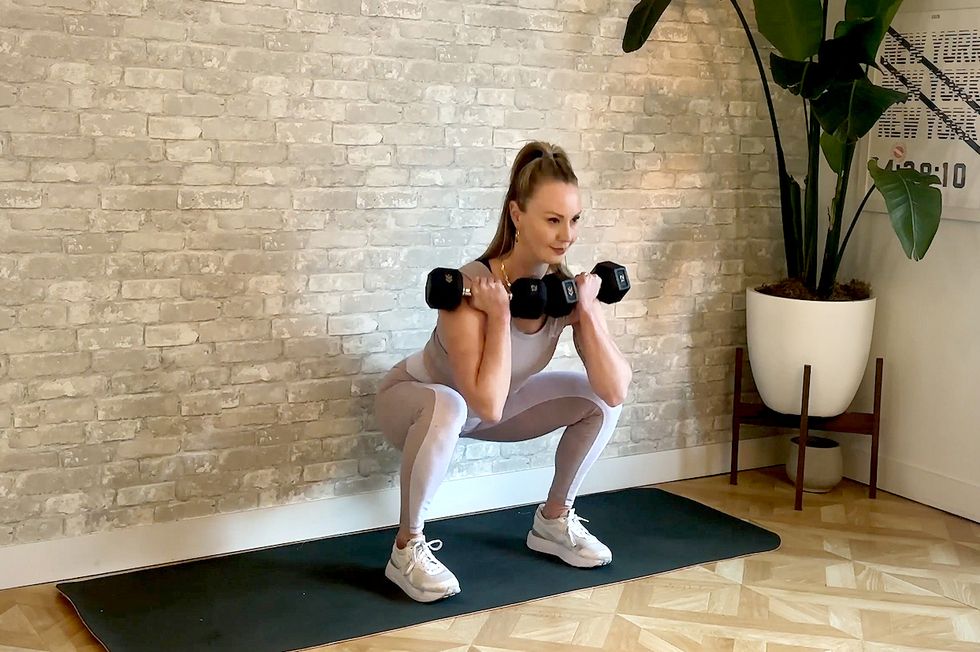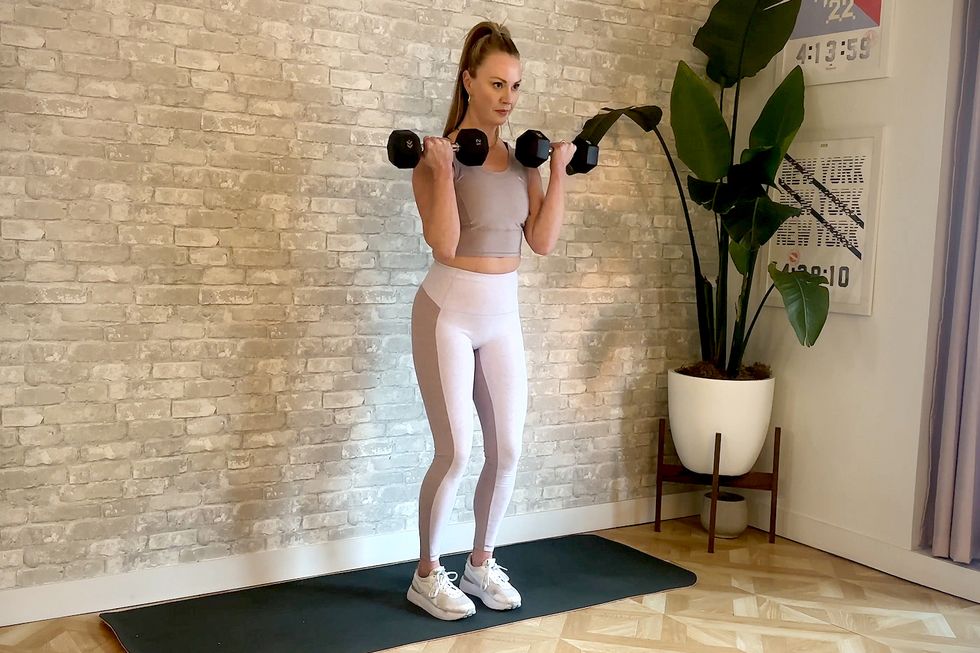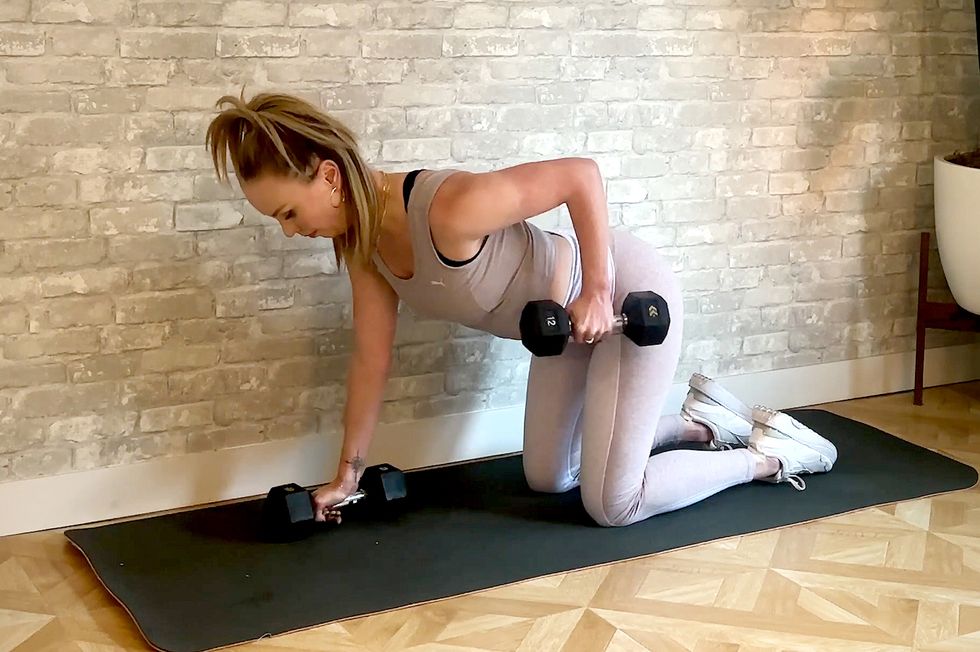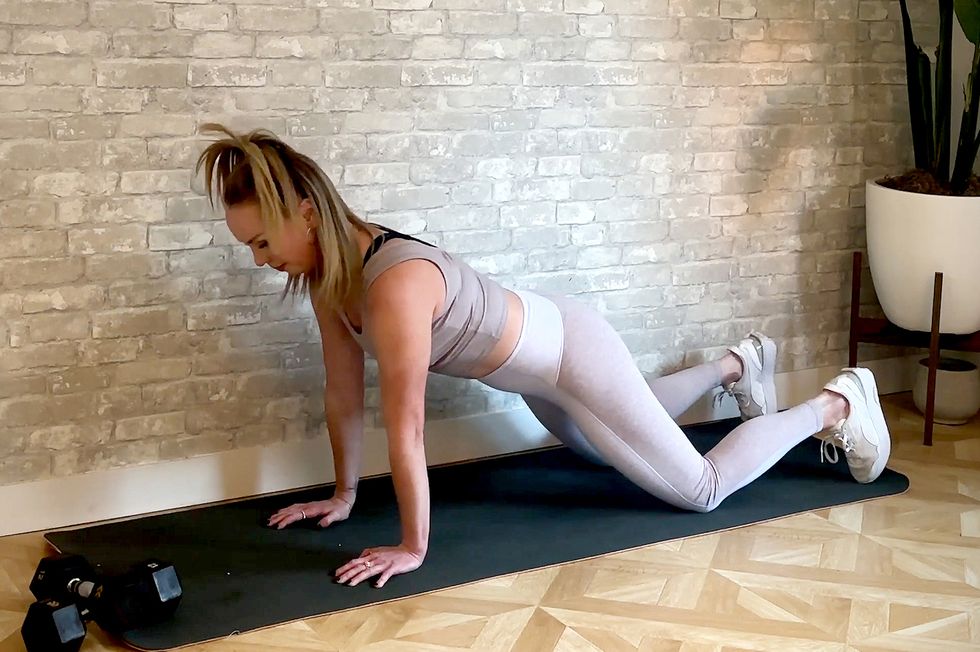“Strength training is every runner’s secret weapon!” says Lindsey Clayton, senior instructor at Barry’s in New York City and co-founder of the Brave Body Project. “A balanced strength-training routine that complements your runs will increase muscular strength, improve running economy, increase coordination, speed, agility, and power, and prevent injury.”
That’s a lot of benefits you can gain from picking up some weights and moving through full ranges of motion. Yet, so many runners treat resistance training as an afterthought or skip it altogether—or are too overwhelmed and confused to know where to start. This list of strength exercises for beginners makes it more approachable.
Why Runners Should Do These Strength Exercises for Beginners
Whether you’ve avoided the weight room because you think don’t think you have the time to lift, or you just don’t know where to start, Clayton’s choice of strength training exercises for beginners provides the perfect entry into weightlifting. This workout includes six moves, requires minimal equipment, and can be customized according to the athlete.
“The circuit can be completed two to four times, depending on the experience level of the athlete and the amount of time they have to work out,” Clayton says. “These workouts don’t need to be incredibly long or intense to be effective. Especially for beginners, starting with the basics and learning proper form is essential. From there, the runner can work on building consistency, adding heavier weights, more reps, or more time to their workouts.”
Clayton recommends runners incorporate strength training into their schedules two to three times a week—and that’s full-body strengthening, not just the glutes and legs. “It's important for runners to have a balanced strength-training program that targets the entire body, not just the lower body,” Clayton says, as posture, arm swing, and core stability significantly influence running performance.
How to use this list: Perform the exercises below as a circuit, meaning do one exercise, then the next in order that they’re listed. Then repeat from the top for 2 to 4 total rounds. Rest 30 to 60 seconds between rounds. Rest as needed between exercises.
Each move is demonstrated by Clayton in the video above so you can master the proper form. You will need a set of dumbbells and an exercise mat.
1. Squat
Why it works: The basic squat strengthens the entire lower body, especially the glutes and quads, which power your run and forward propulsion.
How to do it: Stand with feet slightly wider than hip-width apart, toes turned slightly out, holding a dumbbell in each hand, at shoulders with elbows bent. Keep chest lifted as you send hips back and down and bend knees to lower into squat. (Aim to lower hips to below knee-level or as low as you can while keeping chest lifted and lower back neutral.) Drive through feet to stand back up. Repeat. Do 12 reps.
2. Deadlift
Why it works: Want to develop your glutes and hamstrings? Start with the deadlift. Strong glutes help stabilize the pelvis, which is crucial to injury prevention, and the hamstrings are a source of speed and power, especially when tackling uphill terrain.
How to do it: Holding a dumbbell in each hand, stand with arms at sides and in front of hips (palms facing body) and feet hip-width apart. With a soft bend in knees, hinge at hips by pushing butt straight back, and lower torso toward floor. Keep core engaged, back flat, neck neutral, and dumbbells close to legs. Lower until torso is about parallel to floor. Drive feed into floor to stand back up, squeezing glutes. Repeat. Do 12 reps.
3. Reverse Lunge
Why it works: If lunging forward bugs your knees, opt for the reverse lunge. Like the forward lunge, it fires up every muscle in your leg, including your glutes down to your calves. Stepping backward rather than forward offers a little more stability and can help prevent your front knee from traveling too far forward, which can happen in a front lunge and lead to knee aches.
How to do it: Stand with feet hip-width apart, holding one dumbbell in each hand down by sides. Step back with right foot, bending both knees about 90 degrees so back right knee hovers just off the ground and front thigh is parallel to floor, left knee over toes. Drive through feet to stand up, stepping right foot forward. Repeat with left foot stepping back. Continue alternating. Do 10 reps per side.
4. Biceps Curl
Why it works: It’s not all about the legs! Working the upper body builds overall muscular endurance, meaning that your body is slower to fatigue on training runs and during races—this is particularly important when it comes to posture and form. Building strength in the arms also pays off in a more effective arm swing.
How to do it: Stand with feet shoulder-width apart, arms at sides, holding a dumbbell in each hand with palms toward each other. Keeping arms close to torso, bend both elbows to lift dumbbells up toward shoulders, rotating forearms so that palms face up and then toward shoulders at the top of the lift. Lower dumbbells back down, rotating forearms so palms face in toward each other. Repeat. Do 10 reps.
5. Quadruped Row
Why it works: While you’ll feel this movement in your arms and shoulders, the quadruped row primarily targets the muscles of the back, including the latissimus dorsi, rhomboids, and trapezius. Building back strength combats common postural problems, like rounded shoulders, which can introduce inefficiencies to a runner’s form.
How to do it: Start on all fours with knees hip-width apart, shoulders over wrists, and knees under hips. Place each hand on a dumbbell, palms facing in toward each other. Maintaining a flat back and neutral neck, engage core and draw shoulders down and back. This is the starting position. Pull left dumbbell back and up to hip, keeping elbow close to body. Then straighten arm to return to starting position. Repeat with right dumbbell. Continue alternating. Do 10 reps per side.
6. Modified Triceps Push-Up
Why it works: Tweaking the arm and shoulder positioning of a traditional push-up shifts the effort to the triceps, which power your arm swing. Push-ups also work the core muscles, which support posture and provide overall stability.
How to do it: Start in a modified plank position with wrists under shoulders, neutral neck, flat back, and both knees on the ground and hip-width apart, so body is forming a straight line from head to knees. Bend elbows straight back to lower chest toward the floor, keeping elbows close to ribs to target triceps. Keeping back flat and core engaged, press hands into floor to push body back up to modified plank position. Repeat. Do 10 reps.


















